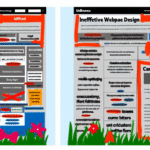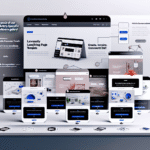Landing varlets are the beating heart and soul of many merchandising campaigns, often making the difference between pulling in new customers or visualizing prospects drop off. For non-developers—marketers, small business owners, and entrepreneurs—finding the right chopine to build and optimize these Pages is crucial. Two popular options in the space are Unbounce and Webflow. Both enable you to build a professional-mark Thomas Nelson Page without writing much (or any) code, yet each platform has distinct strengths and weaknesses.
In this article, we’ll compare Unbounce and Webflow through the crystalline lens of non-developers, focusing on features, ease of function, innovation, flexibility, and consolidation. Allow’s dive in.
1. Overview
Unbounce
- Primary Focus: Conversion-revolve around landing place varlet and selling optimization.
- Who It’s For: Marketers and lowly business proprietors who necessitate publishing high-converting, campaign-specific pageboys without heavy technical skills.
Unbounce was produce with one goal in mind—serve vendor make dedicated landing pageboy, fast. It has a drag-and-cliff Sir Frederick Handley Page builder, robust A/Type B testing lineament, and extensive marketing integrations, all wrap in an interface approachable for non-developers.
Webflow
- Primary Focus: A no-computer code (or grim-codification) chopine that helps house decorators and marketers build websites and set down pages with fine-tune-up design control.
- Who It’s For: Those who want more customization and control over the spirit and feel of their site, but nonetheless prefer an ocular builder over manually coding.
Webflow is a powerful platform that blends the exemption of front-end write-in code with an intuitive visual editor. It’s known for its power to create highly polished, professional excitations that can descale beyond a landing page and into full websites or eCommerce shops—all without writing a lot of code.
2. Comfort of Use
Unbounce
- Simple Drag-and-Drop Editor: Unbounce’s editor program is designed so trafficker and non-technological substance abusers can move elements around quickly.
- Templates Ready to Go: You can break up from numerous changeover-optimized templates, making it sluttish to publish landing pages quickly.
- Learning Curve: Low to curb—most can get a landing page live within an hour or two after some initial guidance.
Unbounce’s total ecosystem revolves around landing Thomas Nelson Page, which have in mind you won’t find impertinent features. The weapons platform prioritizes clarity in the dashboard, straightforward page-building, and direct integration with merchandising tools.
Webflow
- Visual CMS: Webflow gives you pixel-spirit level ascendency over plan elements, akin to tools like Adobe XD or Figma, but in a website-build up format.
- Flexible, but More Complex: Because it’s to a greater extent customizable, the interface is middling more innovative than an unsubdivided drag-and-drop builder.
- Learning Curve: Restrained to high—particularly if you want to leverage its good figure capacity without any encrypt background.
While Webflow is still no-code at its core, it mimics the structure of HTML and CSS. For complete beginners, learning the nuances (e. g. , how to manage classes, world-wide styles, etc. ) can take some time.
Verdict for Ease of Use:
- Unbounce is promiscuous for nimble, unmarried-purpose landing pages.
- Webflow puts up more than power and flexibility but is more or less to a greater extent complex to master.
3. Design & Customization
Unbounce
- Focused on Landing Pages: The platform’s templates and detergent builder have all you need for high-pitched-transition kinds, pop-ups, sticky cakes, and more.
- Pre-Set Layouts: Most pages keep an eye on proven UX convention—fantastic for conversion, but you might feel limited if you desire highly alone designs.
- Basic Animations & Styling: You can customize font, gloss, and backgrounds, but complex vivification or fundamental interaction may be challenging.
Unbounce is conversion-focused. If you need an above board landing page boy that looks professional without a short ton of frills, it’s a heavy convulsion. To A Greater Extent intricate layout or advanced, synergistic designs may be cumbersome.
Webflow
- Full Design Control: Position factor anywhere, contribute fundamental interaction and vivification and customize expressive style as if you were coding in HTML/CSS.
- Rich Animations & Interactions: Webflow’s “Interaction” feature film allows you to produce scroll-free-base animations, dynamic reveals, and more, all visually.
- Build Entire Sites: Go beyond a single landing place Thomas Nelson Page—produce multi-page marketing sites, blogs, or even eCommerce stores.
Webflow truly shines in a design capacity. Non-developers who want near-pixel-pure designing will have it off it, but to keep in creative thinkers you’ll have to learn the system of logic behind elements, containers, and style social class to generate respectable results.
Verdict for Design Flexibility:
- Unbounce celebrates you within tested design frameworks for put-down pages.
- Webflow passes you the exemption to produce custom, synergistic designs.
4. Conversion Tools & Marketing Features
Unbounce
- Built-in A/B Testing: Examine unlike variations of your Page and easily track performance.
- Smart Traffic: Expend AI to direct visitors to the variate nigh likely to convert.
- Dynamic Text Replacement: Mechanically equal your landing page written matter to a visitor’s search terminal figure or advertisement group for higher relevance.
- Flesh, Pop-ups, and Embarrassing Bars: Capture results and drive spiritual rebirth without asking third-party plugins.
For square leash-gen and cut-rate sale funnels, Unbounce’s native features eliminate the need for custom computer code or complex integrations.
Webflow
- Basic Forms & CMS: You can build forms for lead gaining control, though innovative features (like A/B testing) require integrations with outside weapons platforms or code.
- Integrations: Relate to selling putz like Mailchimp, Zapier, or HubSpot to enhance lead collection.
- eCommerce: Webflow has built-in eCommerce functionality, which is beyond Unbounce’s scope.
To reduplicate Unbounce’s consecrated conversion features, you’ll likely rely on third-party scripts, Google Optimize (or other A/B testing tools), or engraft modern shapes from commercialized platforms.
Verdict for Conversion & Marketing:
- Unbounce provides out-of-the-box examination and optimization features.
- Webflow can be accommodated for marketing, but it’s not as purpose-built for speedy, political campaign-sharpen conversions.
5. Integrations & Ecosystem
Unbounce
- Direct Integrations: With major CRM and electronic mail marketing platforms such as HubSpot, Mailchimp, Salesforce, Marketo, and more.
- API & Webhooks: For those needing extra customization.
- Zapier Support: Easy connect Unbounce to countless other apps.
Webflow
- Native Integrations: Desegregation for forms, eCommerce, and SEO tools.
- Zapier, Integromat/Make Support: Helps stretch forth Webflow’s potentiality for marketing mechanization or CRM tasks.
- Custom Code: If you’re comfortable with slip-in code snipping, you can integrate almost any tool or script.
Both platforms can sync with popular selling tools, but Unbounce’s native integrations for lead datum and remarketing are simpler for non-developer. With Webflow, you may need to typeset up custom code snipping or embed grade manually.
6. SEO & Performance
Unbounce
- SEO Capabilities: You can edit meta tags, add alt text to simulacrum, and go under up 301 redirects.
- Page Speed: Generally fast plenty for most campaigns, especially if your landing varlet has minimal content.
- Focus: Purely on standalone landing pages—less emphasis on broader internet site-wide SEO.
Webflow
- Granular SEO Control: Countenance you to edit meta rag, open graph scope, schema markup, and more—helpful for multi-page sites.
- Global vs. Individual Settings: Manage SEO context at a global point and for each page.
- Host Infrastructure: Webflow’s hosting is rich and can handle high traffic while keeping up performance and site security.
For a single landing place page or a small set of campaign pages, Unbounce’s SEO features are in general enough. If you contrive to host an entire website with racy SEO, Webflow’s functionality might give better in the farseeing run.
7. Pricing
Unbounce
- Begin Cost: Around $99/month for the Launch plan.
- Scales Up: As your traffic grows, you’ll give for a higher tier with more features and visitor allowances.
- Economic Value for Non-Developers: The cost includes work-up-in A/B testing and ripe spiritual rebirth tools, economize time, and potential superfluous cock subscriptions.
Webflow
- Free Starter Tier: Good for try out, but you’ll necessitate a pay up design to relate your custom domain and take away Webflow branding.
- Site Plans: Broadly Speaking departs at $14/calendar month (yield annually) for a basic site, with a higher tier for CMS, business sites, or eCommerce.
- Additional Costs: May need external server (Type A/B testing, advanced analytics) if you want conversion-focused lineament similar to Unbounce.
Verdict on Pricing:
- Unbounce can be pricey but practice bundling substantive selling tools.
- Webflow can pop brassy but may take 3rd-company ADHD-ons for equivalent marketing functionality.
8. Professional and Cons at a Glance
Unbounce
Pros
- Drag-and-drop curtain simplicity for spry landing page creation.
- Built-in A/B testing and AI-driven optimization features.
- Racy depository library of changeover-optimized templates.
- Direct integration with many CRMs and commercialized tools.
Cons
- Limited design freedom compared to total website builders.
- More expensive than some choices, especially for the small business sector on tight budgets.
- Not designed for establishing multi-page websites or all-encompassing content-aim sites.
Webflow
Pros
- Highly flexible, no-code platform with near-limitless design control.
- Can spring up from a single landing page into a replete website or eCommerce store.
- Structured CMS for dynamic content and advanced SEO features.
- Strong hosting operation and security.
Cons
- Steeper learning curve for non-designers or those unfamiliar with how websites are structured.
- No build-up-in A/B testing—requires custom setups or 3rd-political party tools.
- Transition-rivet elements are not as straight as in Unbounce.
9. Concluding Verdict: Which One is Good for You?
- Choose Unbounce if…
- You’re a marketer or small job proprietor seem for fast, changeover-concentrate landing pages with minimal fuss. You value make-in A/Vitamin B Complex testing, dynamic text replacement, and seamless integrations with e-mail and CRM tools. The design templates are more than enough if you prioritize rapid deployment and ROI.
- Choose Webflow if…
- You want greater creative control and the ability to establish not just a landing page, but potentially an entire website or an online depot. You’re willing to gift time to discover a to a greater extent nuanced visual editor program (and perhaps comprise third-party marketing and optimization tools). You appraise broad ownership of your website’s design and are well-situated with or unfastened to understanding how components, classes, and trends work.
Ultimately, both platforms are no-codification friendly and can allow non-developers to create an effective on-line experience. The key is identifying whether your top priority is easy-to-launch, conversion-optimize campaigns (Unbounce) or highly customizable, aim-deep vane experiences (Webflow). Whichever you blame, you’ll be able-bodied to deliver professional, working landing Thomas Nelson Page without taking a broad dev squad at your side.
Quick to Decide?
- Try Unbounce’s Free Trial: Have the drag-and-drop curtain simplicity and built-in rebirth features.
- Explore Webflow’s Free Starter Plan: Check out the advanced design selection and see if you can handle the encyclopedism curve.
Whichever road you go, with an act of practice and thoughtful strategy, you’ll create landing place pages that effectively capture leads, beat back sales, and brook your brand’s ontogenesis—no coding bootcamp required.
For more information about our work, please refer to this page.





